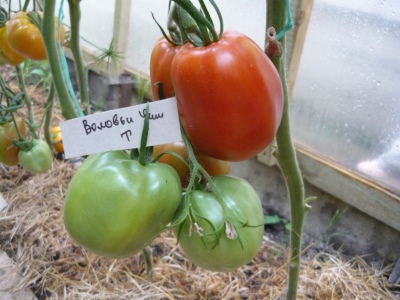
- Authors: Kotelnikova M.A., Kondakov S.N., Agrofirm "Seeds of Altai"
- Year of approval: 2010
- Category: grade
- Growth type: determinant
- Appointment: fresh consumption
- Ripening period: mid-season
- Ripening time, days: 110-115
- Growing conditions: for open ground, for film greenhouses
- Marketability: high
- Leaves: green, medium
In order to diversify the collection of tomatoes in the garden, you should pay attention to the determinant variety Volovye Ears, although many summer residents are already familiar with it. Its fruits with high marketability are used fresh, for making juices, sauces, winter salads, for example, lecho. The plant is grown in open ground, film and polycarbonate greenhouses.
Breeding history
The originators of the variety are the breeders of the Altai Seeds Agrofirm MA Kotelnikova and SN Kondakov. The tomato was approved for use in 2010.
Description of the variety
The determinant variety does not have a growth end point, which forces gardeners to do the pinching. Tall plants in a greenhouse reach 300 cm or more, so they are grown on a support or trellis. Powerful, medium-leafed bushes have rather weak drooping shoots, so they are tied up weekly. The fact that the stems are not too densely covered with foliage can be considered a success - the tomatoes are well ventilated, the risk of late blight is reduced to a minimum. The yellow flowers are collected in a simple inflorescence, forming a raceme with 4-6 fruits, firmly attached to a strong peduncle.
The main qualities of the fruit
Unripe cylindrical, slightly ribbed fruits are light green, but at the stage of ripening they acquire a bright carmine red color. Fruit weight varies depending on conditions - from 106 to 600-700 g.
Taste characteristics
The fleshy pulp of medium density with a large number of seed chambers has a rich sweet taste with a pleasant characteristic aroma. The dense skin protects the fruit from cracking and facilitates long-term transportation. Brown tomatoes removed from the bush tend to ripen successfully without spoilage.
Ripening and fruiting
The culture has a characteristic elongation of fruit ripening. A mid-season tomato yields a harvest for a long time - from 110-115 days until the end of September.
Yield
Yield indicators largely depend on the conditions created for the plant, on average 6.3 kg per sq. meter, however, ideal agricultural technology contributes to a significant increase in yield.
The timing of planting seedlings and planting in the ground
Seeds are planted for seedlings in March, and in the ground - after 60-65 days, in the phase of at least one flower cluster and 6-7 leaves.

Growing tomato seedlings is an extremely important process, because it largely depends on whether the gardener can harvest at all. All aspects must be taken into account, from seedbed preparation to planting in the ground.
Landing scheme
In order for the bushes to have free space for growth, for optimal ventilation and unimpeded access of air, the roots are planted no more than three pieces per m2.

Growing and caring
The tomato is grown in the classic seedling method. Seeds are sown in March, two months later, adult seedlings are transplanted to a permanent place in a greenhouse or open ground. The site should be well lit, fertile land, breathable, with a neutral acidity level. Open ground is recommended only for the southern regions, in other areas greenhouses are needed, otherwise labor costs will not justify themselves, and the yield will be minimal. The soil is enriched with organic matter and mineral fertilizers, acidic soils are deoxidized with bone or dolomite flour, one tablespoon of wood ash is added to each hole.
If the soil needs to be loosened, then add river sand, rice or buckwheat husks. In addition to the fact that the husk makes the soil loose and breathable, it enriches it with minerals and attracts the earthworm. Further care consists in the formation of a bush in 1-2 stems, watering, loosening, weeding, dressing, preventive spraying from diseases and pests. Unlimited growth forces you to stop, that is, pinch the growth point. Growing in greenhouses requires regular ventilation during hot periods, constant monitoring of the humidity level. A gardener, especially a beginner, must remember that high humidity provokes the appearance of late blight, apical rot, as well as naked slugs. In addition, an enclosed greenhouse space is a paradise for whiteflies and aphids. Another overseas scourge of the nightshade is the Colorado potato beetle. If at the beginning of his appearance he ate exclusively on potato tops, now he has successfully mastered peppers, eggplants, and tomatoes.




A plant needs different micronutrients at each stage of growth. All fertilizers can be divided into two groups: mineral and organic. Folk remedies are often used: iodine, yeast, bird droppings, eggshells.
It is important to observe the rate and period of feeding. This also applies to folk remedies and organic fertilizers.
Disease and pest resistance
To the credit of breeders, this excellent variety is almost not susceptible to diseases and pests, however, prevention with insecticides and fungicides will certainly help to avoid late blight, viral tobacco infection (TMV), as well as aphids, slugs, whitefly, spider mites.


Resistant to adverse weather conditions
Bovine ears perfectly tolerate a cold snap.
Growing regions
The tomato is intended for cultivation in all areas of the vast country with different climatic zones. Northern, Northwestern and Central districts, Volgo-Vyatka region, Central Black Earth region and North Caucasian Federal District, Srednevolzhsky, Nizhnevolzhsky, Uralsky, West Siberian, East Siberian, Far Eastern regions.

























































































